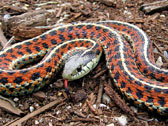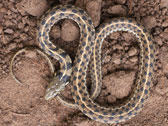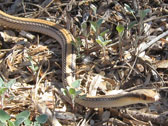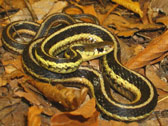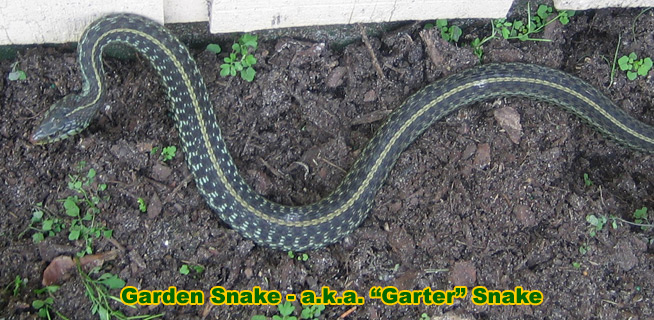
There is no such thing as a Garden Snake, at least not in official name. But plenty of people use the term Garden Snake, so I guess like all popularly misused words, it's real enough.
Here is some information about the
Garter/Garden Snake, which some people also call the Gardener Snake, or Gardner Snake:
Biology:
The Garden snake is one of the most common snakes in North America. There are many varieties and subspecies, but all are thin with a long stripe along the spine, in the middle and usually a stripe along the side, running the length of the body as well.
Many people have dubbed the Garden snakes the ‘garden snake’, as it’s so often found in suburban gardens. This species of snake are usually around 2 to 3 feet long but, on occasion, have been found to grow as large as 4 feet. The
Garden snake has a similar biology to the majority of other snakes found in North America. The color of a Garden is usually very dark and earthy – with tan or even red or yellow or green stripes down the middle of its body. Some people think
a Garden snake looks similar to a rattlesnake, but the main difference being that a Garden snake is much thinner, usually much smaller, the colors are totally different, a rattlesnake does not have stripes, the head isn't as broad, and its tail does
not rattle when it feels threatened. Come to think of it, a garden snake doesn't at all look like a rattlesnake, or any other kind of poisonous snake.
Click any of the below Garter Snake photographs for a high-resolution image:
Habitat: Garden snakes are found throughout North America and are one of the most common types of snakes. They are probably the most commonly spotted type of snake in the United States. They have also been found to live in Alaska, making them one of the most northern snake species on the entire planet. It’s hard to pinpoint exactly what the habitat of a Gardner snake is as they tend to live in a multitude of different environments. In the west, Garden snakes are much more aquatic than snakes from the east. This may be due to their proximity to water or, some scientists believe, may have to do with the different climate the western part of North America produces. In general, northern populations of Gardener snakes will hibernate together – likely due to warmth – then snakes from the south. A famous characteristic of Garden snake habitat is the ‘Garden gathering’ in Manitoba. These Canadian snakes will travel as far as 30 kilometers to reach a secluded winter den in Manitoba. Thousands of snakes hibernate here, making it one of the largest Garden snake dens on the planet.
Behavior: Garter, I mean Garden snakes are known to have a complex system of pheromone communication; in other words, Gardener snakes will communicate with each other based on different smells. Each Garden snake leaves a ‘smell’ trail that other snakes can easily follow; furthermore, male and female smells are entirely different from each other, allowing, when the time comes, for mating season to be an effective process. In general, Garden snakes are a very docile species of snake. However, if aggravated, the snake may coil and strike. They are nonvenomous snakes that, when faced with danger, will discharge a musky-scented odor. This technique is often used to escape when being chased by predators. A common behavior by Garden snakes is to escape into water. Garden snakes like to bask in the sun to regulate their body temperatures.
Diet: The diet of a Gardener snake is much smaller than most snakes. This is because they are a smaller breed of snake and, furthermore, because they have a very unique taxonomy. Their diet mainly consists of any creature they are able to kill, including slugs, leeches, lizards, birds, fish and small rodents. In the west, where the snake is much more aquatic, they have been known to consume other water animals (such as frogs). When they eat, their food is swallowed whole and digested at a very slow rate. Gardner snakes that are found in garden environments in suburban areas have a different diet than the more ‘earthy’ snakes. They tend to eat worms and smaller birds which populate the area. Their unique diet is just another prime example of how Garden snakes adapt completely to whatever environment they are in.
Reproduction: Before mating, Garden snakes go into what is called brumation. This means they will stop eating for around two weeks to make sure that their stomachs are completely clean and clear. As soon as this period of time is over, they will begin mating. During mating, males will mate with as many females as possible; often, males will finish their fasting process first and thus be fully prepared for when females finish their period of brumation. It will take two to three months before a baby snake will be born; the length of time will depend on the number of snakes being born. This can range from 3 snakes to 80 snakes being born within a single litter. At birth, the young baby Garden snakes will begin life independent from their mother. The most snakes born in a single litter is 98.
Is a garden snake poisonous? No, the garter snake is not a venomous snake, and is of course totally harmless. A lot of people ask me if a garden snake is dangerous or not, so I just want to clarify here that it is not a venomous snake, it has tiny little teeth, and feeds on bugs and frogs and such, and the larger ones eat mice, so they're good to have around.
The confusion with the correct term for Garden Snake. What type of snake is it? The proper term is "Garter Snake", so named because this snake closely resembles the fancy frilly garters that proper ladies wear around their meaty thighs. It makes much more sense to name the snake after this location than naming the snake after another place, such as on the ground amongst the plants, like in a garden. I've seen many more snakes wrapped around women's legs than in gardens, so I find it odd that people would mistake the name of this snake. There are many different species of Garter Snake.
Many people want to know how to kill a Garden Snake, but you don't need to. The best way to get rid of Garden Snakes is to simply leave them alone. You can also use a Garden Snake trap to catch them - that's one of the best ways for how to remove Garden Snake. For more information, go to my Snake Removal - How to Get Rid of Snakes home page.
If you need Garden Snake removal in your city, I have friends that I have personally trained in these cities:
